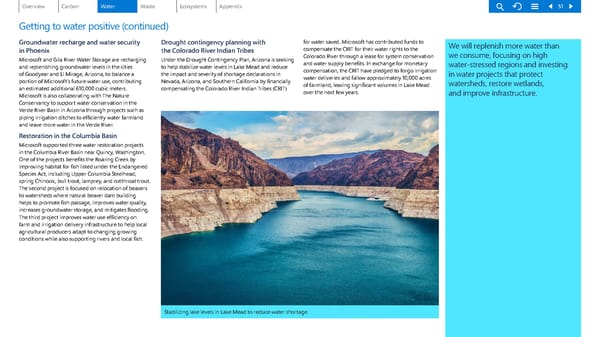Getting to water positive (continued) Groundwater recharge and water security in Phoenix Microsoft and Gila River Water Storage are recharging and replenishing groundwater levels in the cities of Goodyear and El Mirage, Arizona, to balance a portion of Microsoft’s future water use, contributing an estimated additional 610,000 cubic meters. Microsoft is also collaborating with The Nature Conservancy to support water conservation in the Verde River Basin in Arizona through projects such as piping irri gation ditches to efficiently water farmland and leave mor e water in the Verde River. Restoration in the Columbia Basin Microsoft supported three water restoration projects in the Columbia River Basin near Quincy, Washington. One of the proj ects benefits the Roaring Creek by improving habitat for fish listed under the Endangered Species Act , including Upper Columbia Steelhead, spring Chinook, bull trout, lamprey, and cutthroat trout. The second project is focused on relocation of beavers to watersheds where natural beaver dam building helps to prom ote fish passage, improves water quality, increases groundwater storage, and mitigates flooding. The third project improves water use efficiency on farm and irri gation delivery infrastructure to help local agricultural producers adapt to changing growing condition s while also supporting rivers and local fish. Drought contingency planning with the Colorado River Indian Tribes Under the Drought Contingency Plan, Arizona is seeking to help stabilize water levels in Lake Mead and reduce the impact and severity of shortage declarations in Nevada, Ari zona, and Southern California by financially compensat ing the Colorado River Indian Tribes (CRIT) for water sav ed. Microsoft has contributed funds to compensate the CRIT for their water rights to the Colorado River through a lease for system conservation and water supply benefits. In exchange for monetary compensation, the CRIT have pledged to forgo irrigation water deliveries and fallow approximately 10,000 acres of farmland, leaving significant volumes in Lake Mead over the next few years. Stabilizing lake levels in Lake Mead to reduce water shortage. We will replenish more water than we consume, focusing on high water-stressed regions and investing in water projects that protect watersheds, restore wetlands, and improve infrastructure. 51
 Environmental Sustainability Report | Microsoft Page 50 Page 52
Environmental Sustainability Report | Microsoft Page 50 Page 52